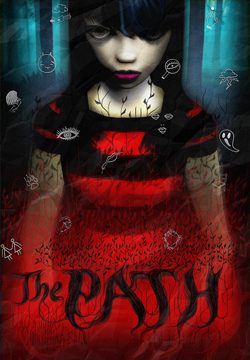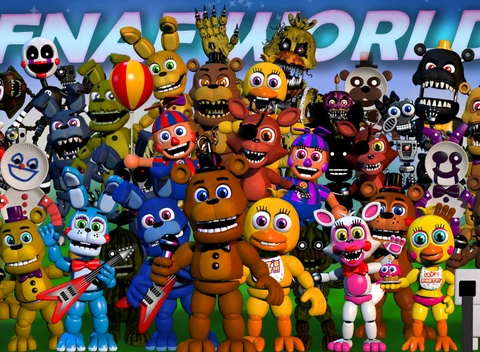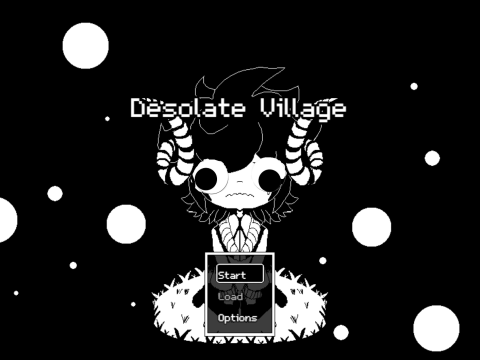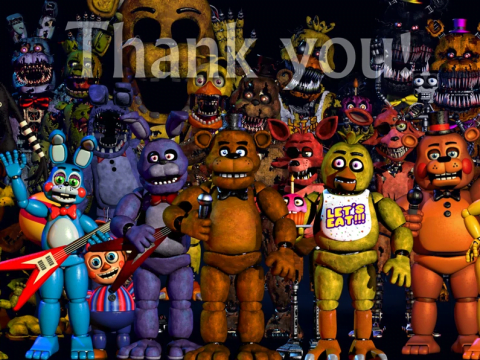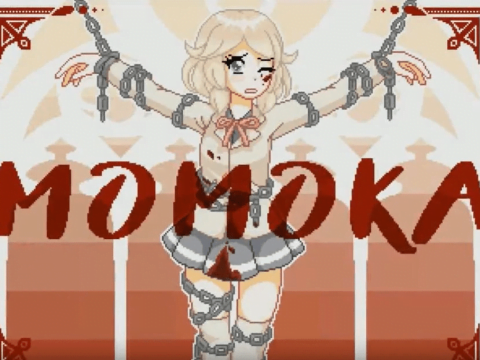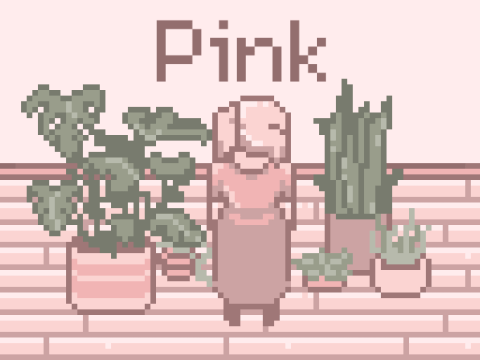
The History and Development of Fear And Hunger
Fear And Hunger was developed by Miro Haverian, more commonly known as Orange, and was released on the 11th of December in 2018. The idea for Fear and Hunger started when Orange asked a classmate about what they would do in morally ambiguous situations that were also incredibly morbid.
And after a few more people joined the discussion, Fear and Hunger was born, sort of. The game itself wasn’t conceptualized until much later, however, as Orange needed to scrape some academic credits together so, remembering that one concept he made back in school, Orange wrote a thesis on his own idea, and the prototype for this game was born.
Gameplay Part 1: The opening, and three mechanics.
As soon as you boot up the game, you’ll be greeted with four characters to choose from, Cahara, the mercenary, mainly characterised by people in the fandom calling him thirsty, D’arce the knight, and the one who’s capable of going batshit crazy if you go for one of the endings playing as her, Enki, the dark priest, the one who the fandom has dubbed the sexiest of all the characters (In Tumblr standards anyway), and Ragnvaldr, the outlander, and one of the most interesting characters in this game, but we’ll get to that later.
After selecting your character, you are given the option of playing through their backstory, as a word of advice, absolutely play through this, it can be a bit lengthy, sure, but it is vitally important if you wish to have a slim chance of completing this game, as rest assured, this game is rough and very unforgiving. It is here where you will also find out why each character came to the dungeon, Cahara, D’arce and Rag all came searching for Captain Le’Garde for their own reasons which I will touch on later, meanwhile, Enki went to expand his knowledge on dark magic.
Anyway, once you finish setting up your character, you will begin at the foot of the Fear and Hunger dungeon, there are two ways to enter, the front entrance, and the side door, you can also search around the dungeon before entering, however, I wouldn’t do this for very long unless you want to become wolf dinner.
After entering your door of choice, you have now sealed your fate and cannot leave the dungeon, the game will notify you through a text box that your hunger and sanity seem to drain faster while stuck here, a statement that most certainly rings true throughout the entire game. Fear and Hunger’s balancing system is based on three things: Your mind, hunger and time. Your sanity and hunger are self-explanatory, if a little different from one another.
Hunger goes down automatically, and can be replenished by eating food found throughout the dungeon, or, if you’re Ragnvalder, you can eat the corpses of fallen enemies, however, even eating has its risks, if you eat rotten meat, or eat a poisoned enemy, you will obtain the poisoned status effect, which will slowly drain your HP over time until you have none left, even outside of combat, the only way to cure this is to either use a white vial or equipping a Thorned ring, both of which are completely RNG based.
Hunger itself also has another quirk, the hungrier your character gets, the weaker they will become in battle, the game at least will notify you when your character starts to feel hungry, with a text box at the bottom informing you that one of your party members is starting to feel hungry. Letting your hunger drop to 0% will lead to a game over, as you would expect.
Mind is your sanity for the game, it, like hunger, will drain over time, with the most common way of bringing it back up is to use alcohol or drugs, which, once again, is RNG dependent. It does have the chance to trigger a cutscene if one of your allies loses too much mind, and you’re in a ritual room, in which you can permanently lose them if you don’t have any mind-healing items on you at that point.
Despite not being a hindrance to the player, time is a main factor in the game, even if you don’t realize it yet. Not only does time translate into how many supplies or supply opportunities you have left, but it also applies to another aspect I will touch on later.
Gameplay Part 2: Combat, Dismemberment and Party Members.
Combat in Fear And Hunger is turn-based. Meaning, that you will take a turn, and your enemy will take a turn after you. You can do a wide variety of things during your turn, these range from your usual attacking and defending, to talking to enemies, much like in Undertale. Generally, it’s not advised that you do this unless you are specifically looking for lore, as talking just gives your enemy a free action. But, there are some instances where talking to an enemy may reward you. Put a pin in this though, we’ll get back to it later.
Anyway, during combat, if you notice an enemy has a weapon on their sprite, you can attack the arm that has the weapon and have a chance of dismembering it. Dismembering the right limb at the right time can be the difference between dodging a coin-flip attack, or praying to lady luck that your character miraculously dodges the one-hit KO attack that Crow Mauler has cooked up.
Dismembering sounds cool, right? Well, here’s the thing. Your character can also be dismembered. Each main playable character starts with two arms and two legs, and if you’re not careful, you can permanently lose all of your limbs, in which case, the game will ask you if you wish to stop breathing. In game of course! Not in real life. On top of this, there are points in the game where you can also lose your sight, which means you will quite literally be playing the game blind, as you can’t see anything but a black screen.
Despite the game doing everything in its power to actively screw you over, it is at least merciful enough to allow you to have some fairly decent party members. Though, some are harder to recruit than others. Each ally has their own hunger and mind meter, which will go down the exact same way as your main character, each ally can also lose their limbs, though, you won’t get an automatic game over if they do. Some characters vary from this, but we’ll get to that later.
Gameplay Part 3: Weapons, Equipment and Magic.
In Fear and Hunger, there are plenty of opportunities for you to nab weapons, armour and even spells throughout the game. If you win a coin flip of course. And TRUST ME, we will be getting to the coin flips later. Anyways, weapons in Fear and Hunger fall under one-handed and two-handed weapons.
There isn’t much difference between the two categories themselves, only that two-handed weapons require both of your arms to work, so, if you find yourself struggling to keep all of your limbs, it would be a good idea to stick to one-handed weapons.
Equipment, similarly to weapons, can fall under light or heavy equipment pieces. While light equipment pieces can be worn by all party members capable of wearing armour, heavy armour cannot be equipped by certain party members, most notably Enki, which might just spark people into calling him a twink now that I think about it.
There are some equipment types that can help you sneak past enemies, for example, wearing the guard outfit can help you sneak past the guards.
As this is an RPG, spells are included in the game, however, they come at the cost of draining mind. So they are, in essence, a limited resource that adds onto the number of contributing factors in the game. Spells can be learned through books and scrolls or, if you choose Enki as your main character go figure, you could start the game with a spell already.
Some spells are combat oriented, such as the spell Black Orb, a spell that attacks one enemy three times for pretty decent damage and only at the cost of 20 mind. Others focus and healing your party, with the spell Loving Whispers coming to mind, a spell that allows you to heal one party member a few points of body and any injuries they’ve sustained minus lost limbs at the cost of 30 mind.
Gameplay part 4: The special party members and coin flips
You remember all the stuff I said “We’ll get back to later”? Well, this is later. As mentioned above, some party members have unique quirks to their characters. For example, Moonless the wolf is an optional party member who initially appears as a mini-boss encounter, you can kill her, with one normal hit. However, recruiting her is where the magic happens. Throughout the dungeon, you will find rotten meat, an item that will poison any human party member who tries to eat it. Keyword. “Human”.
That’s right. If you use the talk option during the Monless boss fight and give her the rotten meat, twice, she will join your party voluntarily. Moonless can’t be controlled like your other party members, however, she can eat rotten meat, meaning you’ve essentially gotten a free puppy that can bite enemies for decent damage and eat anything you give her. Sign me up!
One of the first party members you’ll ever find is a little girl trapped in a cage. Once you find a key scattered around the dungeon, you can free her to add her to your party. She can’t really do much at first, owing to her being five years old. But, there are few things you can do with her.
You can use her as a meat shield for your other party members, or if you’re feeling sadistic. You can give her to Pocketcat for some extremely powerful stuff. The catch? Pocketcat is a paedophile, so you’re essentially trafficking a young girl away to a pedo who has no problem openly showing his predatory nature to you. (Aka, don’t do it. Or forever have me silently judge you through the screen.) That, and you’d be missing out on a really neat party member in the game.
In the courtyard near the beginning of the game, you can find a small dagger, it’s too small to be used by any of your regular party members, however, if you give it to the young girl, she can do a sizeable amount of damage. Not amazing by any means, however, it is enough to instantly destroy enemy heads if she’s lucky enough to land the shot. Meaning, you can effectively turn her into a sniper while your other party members focus on the rest of the body parts.
If she hits the headshot? Great. If not? Well, your other party members are still doing damage so it’s not like that’s much of an issue. Not only that, but you can also teach the little girl any spell in the game. Granted, this isn’t exclusive to her, however, as she’s such a blank slate of a character, you can effectively have her use anything and build her however you want.
Finally, we have, Nas’hrah. Remember when I briefly touched on some party members being harder to get than others? Well, there are a lot of hoops you have to jump through for Nas’hrah. First, you must track down a yellow mage (If you haven’t killed them all already), then talk to that yellow mage until they give you information, then go to the level 2 blood pit and dig around in some meaty meat piles until you find a floating disembodied head named Nas’hrah.
Once in combat with him, flex your new yellow mage knowledge onto him, this will cause him to be impressed and to want to join your team. As Nas’hrah is just a floating head, his hunger will never go down, nor will completely depleting his body kill him permanently. He’ll just turn around and laugh at the player while refusing to do anything during combat, maybe Nas’hrah just likes fucking with you.
Now, the moment you’ve all been waiting for. The coin flips. So, Fear and Hunger is chock-full of RNG, and one of the ways the game loves to test your patience and flex how much RNG Orange is willing to put into a game is through coin-flips. Most enemies in Fear and Hunger have a coin-flip attack, this attack is either a one-hit kill or an incredibly powerful attack that might as well be a one-hit kill.
But coin flips aren’t just for combat. Sleeping in a bed, which is one of the only ways to save in this game, is also a coin-flip, with the only exceptions being a bed at the very start of the game that allows for one free save before then becoming a coin-flip or a game near the very end of the game that requires you to beat up the skin granny before it becomes completely safe. But what happens if you fail a coin flip in bed? I hear you ask and question why I wrote it like that. Well, you’ll be ambushed by a nice powerful enemy that will most likely end your run. So, have fun.
Would you like to hear a secret? Sometimes, you can get a coin flip in the introductory cutscene, really. However, this is only used once, with one option on Ragnvalder’s path requiring you to coin-flip, in which, failure will result in Rag gaining Pantophobia, or a fear of everything.
Gameplay Part 5: Finding Le’Garde & Endings E + D.
Once you reach far enough into the dungeon, you will find Le’Gardge. And here’s where time comes into play. See, if you take an hour or longer to find Le’Garde in real-time. He will be dead once you find him, locking you out of some of the game’s many endings. But rest assured, you can still get an ending if after finding Le’Garde’s dead body, you leave the dungeon. The game rewards you with ending E, basically telling you that you haven’t even found a fraction of anything and to try again.
This is also by far the worst ending in terms of completion, not only because it tells you literally nothing about what happened to Le’Garde, but also more contextually, as your main character basically found nothing.
If you instead continue on to the city of Ma’habre, obtain three souls and defeat François, you may fight the god of love Sylvian, fight a new god version of your character, answer some questions and then achieve ending D.
Gameplay Part 6: Finding Le’Garde Alive & Endings C + C-II
If you’re confused about why this section has been split into two I’ll explain. Both variations of Ending C require Le’Gardge alive in your party, so, I thought it’d just be a little more clear to have this in its own section. Okay? Okay. So, if you complete the game before an hour has passed, you can find Le’Gardge alive and well, and recruit him to your party! Horray! However, gasp! Le’Gardge has amnesia and can’t remember anything but his name- wait what? Is that how amnesia works?
Regardless, Le’Garde will join your party if there is a slot available. One interesting thing to note before we move on to the endings however, is that, if you’re playing as Ragnvalder, you have the option of killing Le’Garde yourself, which, if D’arce is in your party will force a confrontation that will result in you loosing D’arce as you’ll be forced to kill her. This happens as Le’Gardge was the one responsible for the many deaths at Rag’s village, and D’arce is a fellow comrade of Le’Gardge who also canonically has a massive crush on him.
Much like ending D, to get both variations of ending C, you must travel to the city of Ma’habre, collect free souls, send François to the shadow realm and then sit on the lovely yellow throne to reach the void. However, instead of just fighting Sylvian, you must now also battle against, Gasp! Le’Gardge himself! Now transformed into the Yellow King, and revealing right before that he lied about his amnesia, what a dick. Upon defeating him, you will reach ending C. In which you escape the dungeon with a now-dead Le’Garde left to rot.
If you wish to avoid the harsh boss fight against Le’Gardge, you can choose to bow to him, which results in ending C-II, in which Le’Garde becomes the new ruler of the universe, something that I’m sure D’arce has fantasised about more than once.
Gameplay Part 7: Endings B & A + OH MY GOODNESS THE LITTLE GIRL IS EVIL-
Okay. The title is a bit satirical. But you’ll see what I mean in a minute. Ending B is achieved if the player does not have the Little Girl in their party once they reach the meat pit instead of the city. Heading down to the final level while desecrating the dead so many times even Enki would turn his nose up at it, the player will come face to face. With a mantacour- Oh wait sorry, I meant to say the traces of Gro-goroth.
So, not only do you get to beat up Sylvian, Le’Garde as a yellow king and François, you also get to beat up the remains of Slyvian’s husband Gro-goroth. What more could you ask for? Just as a warning, however, if you bring Nas’harah to the fight, he will taunt the older god, causing Gro-goroth to pull an Alicia Keys and set the floating head on fire. Forcing you to battle him one party member short.
After successfully kicking Gro-goroth’s teeth in, he will ask you why you persisted in the fight. Saying anything to him will result in ending B, a rather depressing ending where you never escape the dungeons and are promptly forgotten to time.
Finally, we have the A ending. This requires you to do the same thing as Ending B, except, you must have the little girl in your party. Once you reach the bottom, a cutscene will trigger, the girl will stand on the edge of the corpses, staring off into the distance, you’re character will then begin to get chills running up their spine, meanwhile, the girl remains eerily calm. Eventually, she will fall onto her back and scream, her body twisting and contorting almost like a spider’s legs.
After the first round, the girl will transform, revealing that she is the true God of Fear & Hunger. Quite literally, as she is the God of Fear & Hunger. As the battle progresses, the girl continues to change shape, sporting fewer and fewer human appearances each time. Until eventually, when the battle is won, you’re character is acknowledged by The God you just spent half the game with, causing you to have Pantophobia and rewarding the player with ending A, similar to ending B except that now the God of Fear and Hunger has awoken.
Conclusion
While I would have loved to extend this article by another 700 words detailing everything from Crow Mauler to everyone’s S-ending, I do need to leave some reason for some of you to buy this game.
So, in conclusion, the game is difficult, displays a lot of mature themes, and is certainly not for everyone. However, if you are the type of person who can stomach the mature themes, overcome the difficulty akin to Dark Souls, and deal with the abysmal saving system, then you’ll find a fantastic, story-rich dungeon crawler with some incredible character interactions to boot. With so much attention to detail and clear passion poured into it, that you can look at most Triple-A horror games coming out around this time and laugh.
